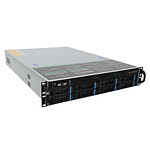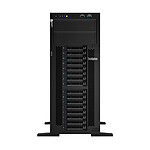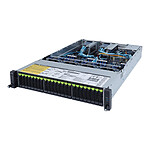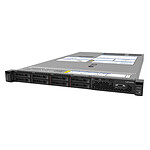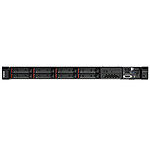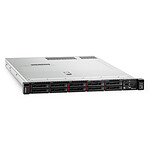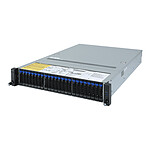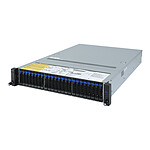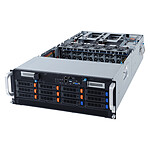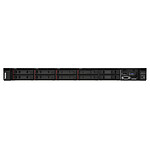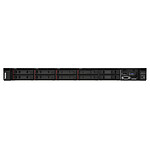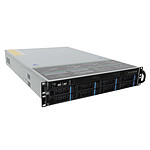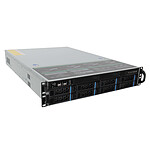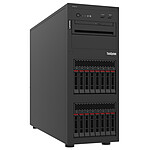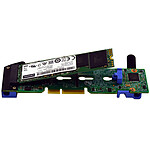Pour pouvoir multiplier votre nombre de serveurs et ainsi étendre votre capacité d'hébergement et de traitement des données, nous vous conseillons d'opter pour nos modèles de serveurs au format rack que nous vous présentons aujourd'hui. Ce type de serveur est conçu pour pouvoir être intégré dans une armoire composée de plusieurs autres serveurs du même format. Ce concept permet de rendre beaucoup plus simple d'une part la gestion de leur alimentation électrique, puisque celle-ci est mutualisée, et la gestion des données d'autre part. Cette solution permet un gain de place évident, tout en ne sacrifiant pas les performances ou
-
LDLC PC SERVEPRO 2U HIGH-END I3
Serveur Rack 2U 8 baies - Intel Core i3-14100 - DDR5 16 Go (2x 8 Go) - SSD M.2 960 Go (2x 480 Go) - Alimentation 550W 80PLUS Platinum - rails de fixation
DispoDispo : -
LDLC PC SERVEPRO 2U HIGH-END I3 (Alimentation redondante)
Serveur Rack 2U 8 baies - Intel Core i3-14100 - DDR5 16 Go (2x 8 Go) - SSD M.2 960 Go (2x 480 Go) - Alimentation redondante 550W 80PLUS Platinum - rails de fixation
DispoDispo : -
LDLC PC SERVEPRO 2U HIGH-END I5
Serveur Rack 2U 8 baies - Intel Core i5-14500 - DDR5 16 Go (2x 8 Go) - SSD M.2 960 Go (2x 480 Go) - Alimentation 550W 80PLUS Platinum - rails de fixation
DispoDispo : -
LDLC PC SERVEPRO 2U HIGH-END I5 (Alimentation redondante)
Serveur Rack 2U 8 baies - Intel Core i5-14500 - DDR5 16 Go (2x 8 Go) - SSD M.2 960 Go (2x 480 Go) - Alimentation redondante 550W 80PLUS Platinum - rails de fixation
DispoDispo : -
LDLC PC SERVEPRO 4U ELITE I3
Serveur Rack 4U 8 baies - Intel Core i3-14100 - DDR5 16 Go (2x 8 Go) - SSD M.2 960 Go (2x 480 Go) - Alimentation 650W - rails de fixation
DispoDispo : -
LDLC PC SERVEPRO 4U ELITE I5
Serveur Rack 4U 8 baies - Intel Core i5-14500 - DDR5 16 Go (2x 8 Go) - SSD M.2 960 Go (2x 480 Go) - Alimentation 650W - rails de fixation
DispoDispo : -
LDLC PC SERVPRO 2U PRO I3
Serveur Rack 2U 4 baies - Intel Core i3-14100 - DDR5 16 Go (2x 8 Go) - SSD M.2 960 Go (2x 480 Go) - Alimentation 600W 80PLUS Gold - rails de fixation
DispoDispo : -
LDLC PC SERVPRO 2U PRO I5
Serveur Rack 2U 4 baies - Intel Core i5-14500 - DDR5 16 Go (2x 8 Go) - SSD M.2 960 Go (2x 480 Go) - Alimentation 600W 80PLUS Gold - rails de fixation
DispoDispo : -
Gigabyte G492-Z51 (rev. A00) (LDLC-20231006-2C)
2x AMD Epyc 7513 128 Go 2x SSD 240 Go + 10x SSD 7.68 To Rack 4U Alimentation 3x 2200W - 2x LAN 10 GbE
DispoDispo : -
Gigabyte R272-Z31 (LDLC-20231006-2A)
1x AMD EPYC 7313 128 Go SSD 512 Go (2x 256 Go) + HDD 10x 7.68 To Rack 2U Alimentation 2x 800W
DispoDispo : -
Gigabyte R272-Z31 (LDLC-20231006-2B)
1x AMD EPYC 7713 128 Go SSD 512 Go (2x 256 Go) + 10x 7.68 To Rack 2U Alimentation 2x 800W
DispoDispo : -
Gigabyte R282-Z94 (6NR272Z34MR-00)
2x AMD EPYC 7282 96 Go Rack 2U Alimentation 2x 1600W
DispoDispo : -
Lenovo ThinkSystem SR250 V2 (7D7QA02QEA)
Intel Xeon E-2356G 32 Go Rack (1U) Alimentation 450W
DispoDispo : -
Lenovo ThinkSystem SR530 (7X08A0CBEA)
Intel Xeon Silver 4208 32 Go Rack (1U) Alimentation 750W
DispoDispo : -
Lenovo ThinkSystem SR630 (7X02A0HUEA)
Intel Xeon Silver 4210R 32 Go Rack (1U) Alimentation 750W
DispoDispo : -
Lenovo ThinkSystem SR630 V2 (7Z71A06GEA)
Intel Xeon Silver 4903Y 32 Go Rack (1U) Alimentation 750W
DispoDispo : -
Lenovo ThinkSystem ST550 (7X10A0CWEA)
Intel Xeon Silver 4208 16 Go Tour (4U) Alimentation 750W
DispoDispo : -
Lenovo ThinkSystem SR630 V2 (7Z71A08AEA)
Intel Xeon Silver 4314 32 Go Rack (1U) Alimentation 1100W
DispoDispo : -
Lenovo ThinkSystem ST550 (7X10A0EKEA)
Intel Xeon Silver 4210R 32 Go Tour (4U) Alimentation 750W
DispoDispo : -
Lenovo ThinkSystem SR250 V2 (7D7QA031EA)
Intel Xeon E-2378 32 Go Rack (1U) Alimentation 450W
DispoDispo :
… l'espace de stockage disponible. Plus une entreprise est importante, plus celle-ci est susceptible d'avoir des besoins de plus en plus conséquents coté serveur. C'est pourquoi ces serveurs racks conviennent très bien à ce type d'entreprise, qui pourront faire augmenter leur nombre de serveurs en fonction de l'évolution de leur activité. Ces serveurs rackables diffèrent des serveurs tour principalement par le format de boitier qui est employé, mais aussi par l'usage qui leur est destiné. Ils sont d'autant plus aux antipodes des barebones serveurs, qui sont eux conçus pour être les plus petits possibles.

